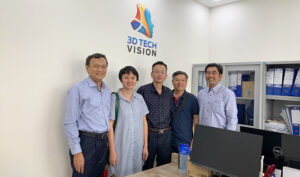You know, today surgeons, dentists, medical professionals are using 3D printing technology as one of the main tools in making medical instruments and products in treating patients. 3D printing has improved the day-to-day work of all healthcare professionals, allowing them to save more lives every day from the creation of medical tools and devices to human parts. The fake is made on request.
3D printing for bone and limb regeneration
It is great news for patients who have lost limbs or bones, today with help of 3D printing, has enabled medical professionals and doctors to manufacture parts such as bones, artificial limbs to gain some of the patient’s loss. 3D printing also helps create custom products that can be tailored to each patient and their bodies.
Here is a video about 3D printed limb reconstruction for patients:
3D printing also has a significant benefit to the dental industry by avoiding time-consuming processes and saving money. In the last few years, additive manufacturing has brought completely new possibilities, from 3D printed braces to 3D printed dentures and crowns, everything 3D printing! This technology now allows for faster implants by avoiding the entire casting process. The dentist can perform all the steps on his own and save valuable time for the patient.
3D printing for internal organ regeneration
More than just bone regeneration, 3D printing in the medical field is starting to show some big improvements to visceral 3D printing. Indeed, this 3D technology also shows that it is possible to print devices that function exactly like our living organs. It could become a real solution to the shortage of donors!
Recently, the first proof of a 3D printed lung concept was developed by Jordan Miller, assistant professor of biological engineering at Rice’s Brown School of Engineering and his team. This lung has been made up of a complex structure. The 3D printing process used to create outstanding evidence of this concept is the Stereoscopic device for tissue engineering. Using light for a digital projector, this bio-printing process produces layered hydrogels.
Here is a video of lung function in 3D:
https://youtu.be/V0rIP_u1JPQ [/ embed]
Bio 3D printing
Did you know that 3D printing tissues and organs are actually becoming possible? This is called biological printing.
Biological printing is not as fast as 3D printing: Biological printing uses bio-inks, a material that allows the bonding and proliferation of living cells. Maturation is part of biological printing because cells have to grow and multiply, which cannot be done immediately. Biological inks are hydrogel biomaterial, providing support to cells while they create their own natural extracellular matrix.
In fact, the first 3D printed heart in human tissue has been developed recently. First, a biopsy on the patient’s adipose tissue must be completed. Then the sample is separated into cells and cells. The next step, the cells are reprogrammed to act as pluripotent stem cells. These cells are mixed with other biological materials such as collagen to create the bio-ink. It is important to mention that the bio-squid itself is superior because it eliminates the risk of organ rejection. 3D hearts are formed.
The Future of 3D printing in Medicine?
There is no denying the benefits that 3D printing technology brings to the cure of patients. However, there is still a lot to be done. That we will do in the future only, I believe so. In the short term, 3D printing is no longer unfamiliar, but actually exists and contributes to the modern medical industry.
—
Reference from: https://www.sculpteo.com/






